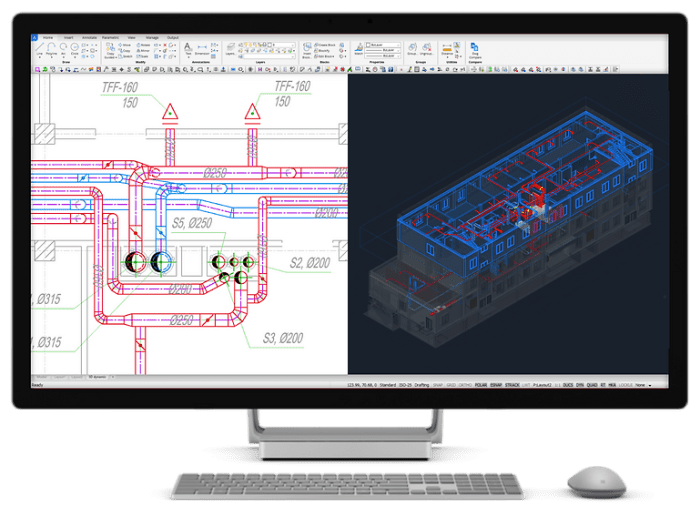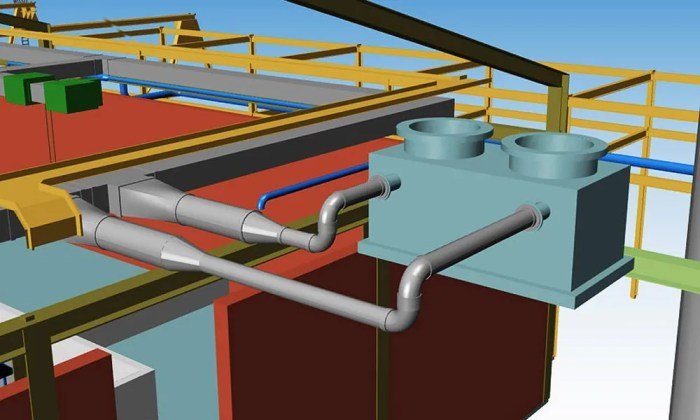The comfort and efficiency of your home’s HVAC system are crucial for maintaining a pleasant living environment. HVAC design software empowers you to optimize these aspects by providing powerful tools for residential projects. With advanced features and user-friendly interfaces, these software solutions enable you to design, analyze, and optimize HVAC systems that meet your specific needs and maximize energy savings.
Whether you’re a homeowner, contractor, or engineer, leveraging HVAC design software can streamline your workflow, enhance precision, and ensure optimal performance of your residential HVAC systems. Dive into this comprehensive guide to discover the key features, top software options, and best practices to harness the full potential of HVAC design software for your residential projects.
Overview of HVAC Design Software for Residential Use
HVAC design software is a specialized tool that assists engineers and contractors in designing and optimizing heating, ventilation, and air conditioning (HVAC) systems for residential buildings. It provides a comprehensive set of features to streamline the design process, enhance accuracy, and ensure compliance with industry standards.
Using HVAC design software for residential projects offers numerous advantages. It enables designers to:
- Accurately calculate heating and cooling loads based on building characteristics and occupancy patterns.
- Select and size HVAC equipment, such as furnaces, air conditioners, and ductwork, to meet the specific requirements of the building.
- Design duct systems that minimize pressure drops and maximize airflow efficiency.
- Create detailed plans and specifications for HVAC installations.
- Generate energy consumption estimates and identify opportunities for energy savings.
Importance of Using HVAC Design Software
The use of HVAC design software is crucial for several reasons:
- Accuracy and Reliability: Software-based calculations are highly accurate and reliable, reducing the risk of errors and ensuring optimal system performance.
- Efficiency and Time Savings: Automation of design tasks saves time and streamlines the process, allowing engineers to focus on critical aspects of the project.
- Compliance with Standards: Software tools incorporate industry standards and regulations, ensuring compliance and reducing the risk of costly rework.
- Improved Communication: Detailed plans and specifications generated by software facilitate clear communication between designers, contractors, and building owners.
- Energy Optimization: Software helps identify energy-efficient design solutions, reducing operating costs and environmental impact.
Key Features to Consider When Choosing HVAC Design Software

When selecting HVAC design software for residential use, it is essential to consider specific features that can enhance the efficiency and accuracy of your design process. These key features include:
3D Modeling Capabilities
3D modeling capabilities allow you to create a virtual representation of the building, including the HVAC system. This enables you to visualize the system’s layout, identify potential conflicts, and ensure proper equipment placement. Advanced software may also offer features like walkthroughs and clash detection, further enhancing the design process.
Load Calculation Tools
Load calculation tools are crucial for determining the heating and cooling requirements of the building. These tools use industry-standard methods, such as the Manual J, to calculate the heat gain and heat loss for each space. Accurate load calculations ensure that the HVAC system is properly sized to meet the building’s needs, avoiding oversizing or undersizing issues.
Equipment Selection Tools
Equipment selection tools assist in selecting appropriate HVAC equipment based on the load calculations. These tools provide a database of equipment options, allowing you to filter and compare different models based on criteria such as efficiency, capacity, and cost. They can also generate equipment schedules and specifications, streamlining the equipment selection process.
Energy Analysis Capabilities
Energy analysis capabilities enable you to evaluate the energy consumption of the HVAC system. These tools use simulation techniques to predict the system’s performance under different operating conditions. By analyzing energy consumption, you can identify opportunities for energy savings and design more efficient HVAC systems.
Top HVAC Design Software Options for Residential Use

When selecting HVAC design software for residential use, there are numerous options available, each offering unique features and capabilities. Here are some of the top HVAC design software options to consider, along with their key features, benefits, pricing, and examples of projects completed using each software:
Carrier HAP
- Features and Benefits: Carrier HAP (Hourly Analysis Program) is a comprehensive HVAC design software specifically designed for residential and light commercial applications. It offers features such as load calculations, equipment selection, ductwork design, and energy analysis. HAP is known for its user-friendly interface, extensive library of equipment and materials, and accurate load calculations.
- Pricing and Licensing: Carrier HAP is available in various licensing options, including a perpetual license and a subscription-based model. Pricing varies depending on the specific features and modules included.
- Examples of Projects: Carrier HAP has been used in numerous residential projects, including single-family homes, multi-family buildings, and small commercial buildings. Some notable projects include the design of HVAC systems for a luxury apartment complex in New York City and a sustainable single-family home in California.
Revit MEP
- Features and Benefits: Revit MEP is a powerful BIM (Building Information Modeling) software that offers comprehensive HVAC design capabilities. It allows users to create 3D models of buildings and integrate HVAC systems within the model. Revit MEP provides features for load calculations, equipment selection, ductwork design, and energy analysis. It also offers advanced features such as clash detection, coordination with other disciplines, and support for sustainable design practices.
- Pricing and Licensing: Revit MEP is part of the Autodesk Revit suite and is available through subscription-based licensing. Pricing varies depending on the specific features and modules included.
- Examples of Projects: Revit MEP has been used in a wide range of residential projects, including high-rise apartments, townhouses, and custom homes. Some notable projects include the design of HVAC systems for a luxury condominium building in Chicago and a net-zero energy single-family home in Colorado.
Trane TRACE 700
- Features and Benefits: Trane TRACE 700 is a comprehensive HVAC design software developed by Trane Technologies. It offers a wide range of features for load calculations, equipment selection, ductwork design, and energy analysis. TRACE 700 is known for its powerful simulation capabilities, allowing users to model complex HVAC systems and analyze their performance under various operating conditions.
- Pricing and Licensing: Trane TRACE 700 is available through a perpetual license or a subscription-based model. Pricing varies depending on the specific features and modules included.
- Examples of Projects: Trane TRACE 700 has been used in numerous residential projects, including single-family homes, multi-family buildings, and small commercial buildings. Some notable projects include the design of HVAC systems for a large-scale residential development in Texas and a high-efficiency single-family home in Florida.
Best Practices for Using HVAC Design Software
To ensure the most effective use of HVAC design software, adhere to these best practices:
Creating Accurate Models
- Input accurate building dimensions and geometry.
- Consider the building’s orientation, location, and climate.
- Include all relevant building components, such as walls, windows, doors, and insulation.
- Use detailed information about the HVAC system, including equipment specifications and ductwork layout.
Optimizing Energy Efficiency
- Select energy-efficient equipment with high SEER or HSPF ratings.
- Design ductwork with minimal pressure drop and heat loss.
- Consider using variable-speed fans and zoning systems.
- Incorporate passive design strategies, such as natural ventilation and daylighting.
Troubleshooting Design Issues
- Use the software’s simulation capabilities to identify potential problems.
- Review the design carefully for errors or omissions.
- Consult with experienced HVAC professionals for guidance.
- Consider using a third-party software or service for independent verification.
Case Studies and Examples of HVAC Design Software in Action
HVAC design software has revolutionized the residential construction industry, providing engineers and contractors with powerful tools to optimize system performance and efficiency. Here are some case studies and examples showcasing the transformative impact of HVAC design software in real-world projects:
Example 1: Optimizing Ductwork Design for Improved Airflow
A residential project in a sprawling suburban home faced challenges with inadequate airflow distribution. Using HVAC design software, engineers simulated various ductwork configurations to identify the most efficient layout. The software allowed them to visualize airflow patterns and pinpoint areas of restriction.
By optimizing the ductwork design, they achieved uniform airflow throughout the home, improving comfort levels and reducing energy consumption.
Example 2: Overcoming Space Constraints with Creative Equipment Placement
In a densely populated urban area, a residential building had limited space for HVAC equipment. HVAC design software enabled engineers to explore different equipment placement options and visualize the impact on airflow and noise levels. By leveraging the software’s 3D modeling capabilities, they found an innovative solution that met both space and performance requirements, ensuring optimal system operation.
Example 3: Reducing Energy Consumption through Load Calculations
A multi-family residential complex aimed to reduce energy consumption and operating costs. HVAC design software was used to perform load calculations, accurately estimating the heating and cooling demands of each unit. Based on these calculations, engineers sized the HVAC equipment appropriately, ensuring efficient operation and minimizing energy waste.
The software’s ability to account for factors such as building orientation, insulation levels, and occupancy patterns contributed to significant energy savings.
Example 4: Enhancing Indoor Air Quality with Advanced Filtration Systems
In a residential project prioritizing indoor air quality, HVAC design software helped engineers select and design an advanced filtration system. The software provided data on the effectiveness of different filter types in removing pollutants and allergens. By incorporating the optimal filtration system into the HVAC design, engineers ensured improved indoor air quality, promoting occupant health and well-being.
Example 5: Troubleshooting System Performance Issues
A newly constructed residential building experienced ongoing system performance issues, resulting in discomfort and energy inefficiency. HVAC design software was used to analyze the system and identify the root cause of the problems. The software’s diagnostic capabilities allowed engineers to pinpoint airflow imbalances, equipment malfunctions, and control system errors.
By resolving these issues, they restored optimal system performance, enhancing occupant comfort and reducing energy consumption.These case studies demonstrate the multifaceted applications of HVAC design software in residential projects. By leveraging the software’s capabilities, engineers and contractors can optimize system design, overcome challenges, and achieve improved performance, efficiency, and occupant comfort.
Final Summary
Embracing HVAC design software for residential projects is a wise investment in comfort, efficiency, and cost savings. By utilizing the advanced features and capabilities of these software solutions, you can optimize your HVAC system’s performance, reduce energy consumption, and create a more comfortable and healthy living environment.
Remember to consider your specific project requirements, budget, and user experience when selecting software. With the right tools and knowledge, you can elevate your residential HVAC designs to new heights, ensuring a comfortable and energy-efficient home for years to come.
FAQ Summary
What are the key benefits of using HVAC design software for residential projects?
HVAC design software offers numerous benefits for residential projects, including improved accuracy in system design, optimized energy efficiency, reduced project costs, and enhanced occupant comfort.
What are the essential features to look for in HVAC design software?
When choosing HVAC design software, consider features such as 3D modeling capabilities, load calculation tools, equipment selection tools, energy analysis capabilities, and user-friendly interface.
Can HVAC design software help me reduce energy consumption in my home?
Yes, HVAC design software can help you optimize your system’s energy efficiency by analyzing energy usage, identifying areas for improvement, and providing recommendations for energy-saving measures.